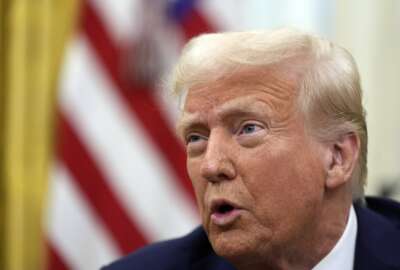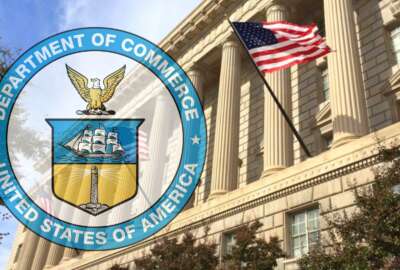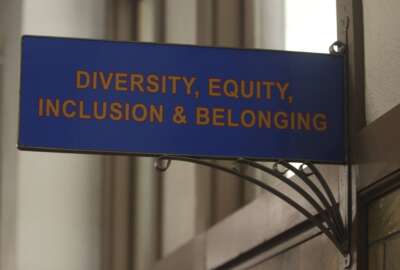Energy Department illustrates how to get clean-energy projects going
In an effort to clear the existing backlog of solar, wind, and battery projects in need of interconnection, the Department of Energy has created a new roadmap.
In an effort to clear the existing backlog of solar, wind, and battery projects in need of interconnection, the Department of Energy (DOE) has created a new roadmap to accelerate some ways to get them connected to the nation’s grid. It is called the Transmission Interconnection Roadmap, and DOE hopes it will help it hit targets for interconnection improvement by 2030. To learn more about this new tool, Federal News Network’s Eric White spoke to Becca Jones-Albertus, the Director of DOE’s Solar Energy Technologies Office on the Federal Drive with Tom Temin.
Interview Transcript:
Eric White So why don’t we just start with an overview of what this interconnection roadmap is? And, just sort of how it all came together, and then we can kind of get into the mission of it.
Becca Jones-Albertus At the Department of Energy. We are focused on how we can enable the president’s goal of decarbonizing our electricity grid by 2035. To get there, we need to rapidly increase the amount of solar, wind, and battery storage that we are deploying. One of the barriers we need to overcome to accelerate that deployment is interconnection. Interconnection along with siting of projects, supply chain challenges. Those are some of the biggest challenges to be overcome to enable greater solar, wind and energy storage deployments. Specific to interconnection, we have seen a substantial rise in the number of projects that are submitting applications to grid operators to interconnect to the grid in recent years, and we’ve seen the backlog of those projects growing tremendously. And so while it used to take just a couple of years to get through an interconnection queue, we’re now seeing projects on average taking five years to come out of queues. We now have as much solar and energy storage in the interconnection queues as we would need to deploy over the next decade to get to our clean energy goals. But at the same time, we’re seeing that less than 20% of the projects that enter those queues are being built. So we’re seeing a problem that’s kind of exacerbating year over year where there’s more projects going into the queues, the queue slowing down, and then there’s less information about which projects will be viable at the end of that process. And so then more projects are put into the queue and we continue to exacerbate that problem. So this is a major issue that we’ve been focused on addressing at DOE. And as one of the major pillars of that work we developed this interconnection roadmap. So we have a larger effort that’s called the Interconnection Innovation Exchange or ITU acts, which is bringing together stakeholders to address the challenges related to interconnection to get to fairer, simpler and more equitable practices. And that effort has been a large stakeholder group. And one of the big pillars has been this roadmap. So over a nearly two year process since we launched the ATX program, we’ve been working to develop the roadmap, had 22 meetings with stakeholders, got feedback from more than 2000 participants on the challenges that need to be solved, pathways to solving those challenges. And the result is a roadmap that we hope can be an integrated solution set to use and its funding opportunities for industry and other stakeholder groups to use, as well in targeting their efforts to improve interconnection processes.
Eric White All right. And forgive me for making us back up even more. Interconnection of that means that the technology is there to generate power, but this is the process of actually connecting it to the power supply.
Becca Jones-Albertus The interconnection process is what the name of the process is called, where a new power plant gets permission from the grid to connect to the grid and to provide power into the grid. And so what has to happen on the grid side is that they have to ensure that particular location can handle that influx of power coming onto the grid, that it can do so in a safe way, and that involves studying what will happen to the grid if you add that power, and studying whether there’s new equipment needed on to the grid, which we often can call upgrades. If there are upgrades, what do those costs? Are they cost prohibitive or not? It studies how that additional power that comes on the grid might contribute to congestion, or might influence adjacent areas. So there’s a number of engineering studies that need to be done to determine whether a particular location is viable for generating a bunch of power and putting it on the grid.
Eric White All right. So it seems as if the current situation might be a good problem to have. You’ve got all this power and infrastructure ready to go. It’s just the actual case of getting it started up. You laid out some of the challenges. Is it just more of a fact of you don’t have everything you need and that’s the reason for the backlog? Or is there just sort of a logjam of just how long it takes to get something implemented into it?
Becca Jones-Albertus There’s a logjam of how long it takes to get through these processes. The models and methods that currently exist today for evaluating the addition of new generation or storage on the grid are not suitable for the volumes that we have. So we’re looking at how can we develop better tools and models to make some of this process more automated and faster? Another source of problem is that today, the developers who are putting these power projects together, they don’t really have any visibility into what locations are good for the grid, and so they end up using the interconnection process to pare down their projects. So they might be looking at five different sites for building a project, and they’re not sure which one will be cost effective to put on to the grid, because they don’t have a way to get that information. So they submit all five into the queue, even though they’re only intending to build one. And so that whole evaluation process has to go through for all five of those projects.
Eric White Just to be told no.
Becca Jones-Albertus Yes. It’s very inefficient. And so another one of the goals is to find ways that grid operators can put this information out there so that they don’t have to go through their whole evaluation process in order for developers to know whether or not a location is good. And that can cut down on the volume a lot, too.
Eric White Gotcha. We’re speaking with Becca Jones-Albertus, who is director of the Energy Department Solar Energy Technologies office. And so let’s get into the actual roadmap itself. I imagine what you just described is in there as well, for reducing the amount of time it takes for interconnection. What are some of the other tools that are laid out in there for developers to consult as they are trying to develop new projects for clean energy?
Becca Jones-Albertus So the roadmap we’ve put together, we want to be a roadmap for all the stakeholder groups. So that’s grid operators, that’s project developers, that’s community organizations, that’s the federal government. That’s others developing solutions. And so it has solutions that are relevant for all of those groups. And then we have a set of funding at DOE that we are putting together that will address some of those targeted solutions. And then other groups may be addressing other solutions. But the roadmap is founded on collecting better data and information, which can help reduce what goes into the queue, improving the processes of evaluating projects in the queue itself, and addressing major barriers like how when you find out that the grid needs to be upgraded, they need to add expensive new equipment, how those costs can be shared in a way that still enables projects to go forward. So sometimes today, it’s just the first project that would trigger that need, that would have to pay the millions of dollars, even though many projects would benefit from that. And so, helping establish some processes for what’s called cost allocation are another aspect or a type of solution in the roadmap.
Eric White The goal is interconnection improvement by 2030. What exactly does that mean? And does that just mean a great reduction of the backlog or a smoother transition for folks trying to get connected? What did you all have in mind when setting that goal?
Becca Jones-Albertus We have set a number of quantitative goals, but basically we want the process to be faster. We want more of the projects that go into the process to result in real projects that go on to the grid, and we want there to be a lot more certainty and understanding of how much it will cost to interconnect the grid.
Eric White Gotcha. And so will this be something that is continuously updated or is this going to be the end all, be all Bible for anyone trying to develop a new project?
Becca Jones-Albertus We think this will be a good document to guide efforts over the next several years. Hopefully at that point we’ll find we’re making a lot of progress and we’ll need an updated document with maybe a smaller number of actions to enable our clean energy goals and get to faster, simpler and fairer interconnection processes. But we’ll have to see how much work we can get done over the next couple years.
Copyright © 2025 Federal News Network. All rights reserved. This website is not intended for users located within the European Economic Area.
Eric White is news anchor and Federal Drive producer at Federal News Network.
Follow @FEDERALNEWSCAST






